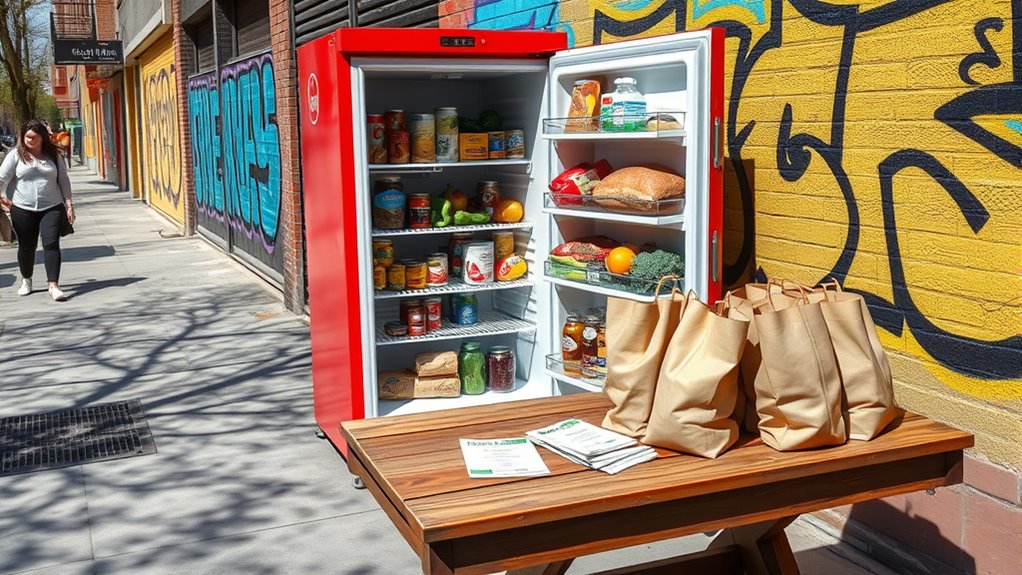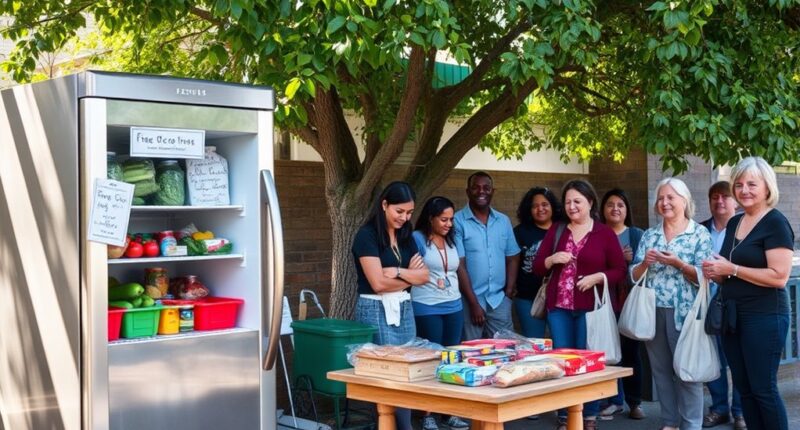To find free groceries through food pantries and community fridges near you, start by searching online or checking local community centers and organizations. Many of these resources are easy to access and don’t require appointments. Community-driven locations often have posted signs or websites with their hours. Volunteering and donating can also support these efforts. Keep exploring to learn how these services can better meet your needs and connect you with additional local resources.
Key Takeaways
- Many organizations list local food pantries and community fridges online or through community centers for easy access.
- Locations are typically free, open without appointments, and widely available within communities.
- Community fridges often operate on donations of food and funds from neighbors and local organizations.
- Volunteer opportunities at these sites include sorting, packing, and distributing food to those in need.
- Check local government or nonprofit websites for directories and schedules of nearby free food resources.

Food pantries and community fridges have become essential resources for those facing food insecurity. If you’re experiencing difficulty putting enough food on your table, these options can provide much-needed relief. Many communities have established these free food sources to help individuals and families access nutritious groceries without financial burden. Locating nearby food pantries or community fridges is often straightforward—many organizations list their locations online or through local community centers. Once you find a place, you can usually visit without an appointment, making it a convenient option during times of urgent need.
Getting involved as a volunteer offers a meaningful way to support these efforts. Volunteer opportunities at food pantries and community fridges are plentiful, allowing you to contribute your time and skills to combat food insecurity in your area. Whether you’re sorting donations, packing bags, or helping with distribution, your efforts directly impact your neighbors who rely on these services. Volunteering also gives you a chance to learn more about the challenges faced by those experiencing food insecurity and to build connections within your community. Many organizations welcome individuals of all ages and backgrounds, and some even provide training for new volunteers, making it easy for you to get started.
If you’re interested in volunteering, check with local food banks or community fridge programs for specific opportunities. Some places need help on weekends or during evening hours, so you can choose a time that fits your schedule. Your presence can make a real difference, whether you’re helping to stock shelves, organize donations, or assist clients directly. Beyond volunteering, many community fridges operate on a donation basis, so you can also contribute food or funds to sustain these crucial resources. Donating perishable and non-perishable items ensures that food pantries and community fridges can continue to serve those in need. Additionally, understanding food insecurity can help you better support and advocate for these vital community programs.
Frequently Asked Questions
How Often Can I Access Food Pantries or Community Fridges?
You can usually access food pantries and community fridges as often as they allow, but it varies by location. Check pantry scheduling for specific hours and frequency, as some offer weekly visits while others might have restrictions. Fridge accessibility often depends on the community fridge’s rules, which may let you visit daily or multiple times a week. Always verify local guidelines to make sure you get the help you need.
Are There Eligibility Requirements to Use These Resources?
Think of food pantries and community fridges as open doors welcoming everyone in. You usually don’t need to meet strict eligibility criteria, but some places might ask for proof of need or residency. Donation procedures are straightforward—bring non-perishable items or a small donation if you can. These resources aim to serve the community, so don’t hesitate to ask about specific eligibility criteria or donation procedures—they’re there to help you.
Do I Need to Bring Identification or Proof of Income?
No, you typically don’t need to bring ID verification or proof of income to access these resources. Most food pantries and community fridges prioritize helping those in need without requiring documentation. However, some locations might ask for ID verification to confirm your identity or ask about your income, especially if they have specific eligibility criteria. It’s a good idea to check with your local resource beforehand to be sure.
Can I Donate Food or Funds to Support These Programs?
You can definitely donate food or funds to support these programs. Many food pantries and community fridges welcome donations, but check their specific donation guidelines beforehand. Your contribution helps sustain their efforts and reach more people. Plus, volunteering offers a hands-on way to give back. Reach out to local organizations to learn about their volunteer opportunities and guarantee your donations make the biggest impact.
Are There Specific Hours When Community Fridges Are Stocked?
Community fridges are typically stocked during scheduled volunteer shifts, which vary by location. To find out specific hours, check with your local organization or website. Volunteers often handle fridge maintenance and restocking during these times, ensuring fresh food is available. You can also offer to join a volunteer schedule, helping keep the fridge stocked and clean, so everyone in your community benefits from reliable access to free groceries.
Conclusion
Finding a food pantry or community fridge can make a real difference when you’re facing hardship. Did you know that nearly 12% of households in the U.S. struggle with food insecurity? By knowing where these resources are, you can access free groceries quickly and confidently. Remember, help is available, and you’re not alone in this. Reach out to local services—you might be surprised at how much support is just around the corner.









